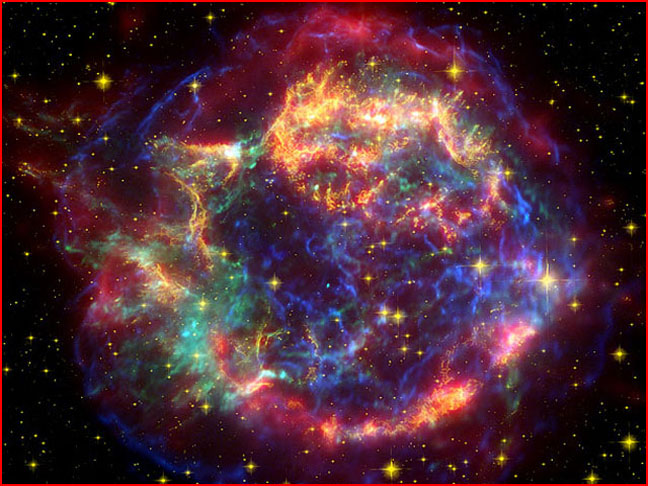
home •
about •
essential guide •
picture of the day •
thunderblogs •
news •
multimedia •
predictions •
products •
get involved •
contact

Credit: O. Krause (Steward Obs.) et al., SSC, JPL, Caltech, NASA
pic of the day
archive
subject index
abstract
archive
Links:
Society for
Interdisciplinary
Studies
Jun 20, 2005
The Supernova Nobody Saw
The enigmatic features of the strongest extrasolar radio source in the sky have been heavily obscured by astronomers’ ad hoc attempts to save preconceived theories. But they are clear manifestations of electrical activity in space.
Cassiopeia A, pictured above in a composite of x-ray, optical and infrared images, is one of the first objects observed by radio telescopes. It is also the strongest extrasolar radio source in the sky. It wasn’t identified with an optical object until 1954, when Walter Baade and Rudolph Minkowski matched it up with a “most remarkable” nebula. Their paper in the Astrophysical Journal (Vol. 119, pp. 206-214) remarked: “[R]ed-sensitive plates ... show ... broken bits of nebulosity .... Some are elongated streaks ..., others have almost stellar appearance .... Not a single one ... registers on the blue-sensitive plates.... [I]t is for the first time that we encounter the type of nebulosity that we described.” Emission nebulae are usually blueish.
Baade’s and Minkowski’s plates only imaged a few parts of the nebula in its northern sector. What they called the “northern arc”, roughly the area shown here near the top in yellow and white, appeared to have “marked motions”—around 2000 kilometers per second—“and intensity changes.... In contrast, the red broken bits ... show neither perceptible motions”—at most, around 50 kilometers per second—“nor intensity changes.” Because an exploding star—a supernova—was expected to throw off a shell of material with a uniform expansion velocity and a uniform luminosity, they concluded, “[T]he nebulosity is not a shell of this type.”
Later astronomers decided it was “a shell of this [supernova] type” and calculated the shell’s expansion back to a supernova explosion that would have been seen in 1667. A search through the historical documents of that time, however, turned up no mention of it. Although it is the youngest and one of the nearest nebulas that are considered to be remnants of supernovas, no one saw the explosion. Perhaps recalling the admonition that “lack of evidence is not evidence of lack”, these later astronomers declared that the explosion had been “heavily obscured” by dust.
Now the Spitzer Space Telescope has measured the “marked motions” in infrared light and has found them to be much too high even for a supernova explosion. The new explanation is a “light echo” (although “heat echo” would be more accurate): The white dwarf remnant of the supernova emits bursts of radiation that heat up tendrils of dust in the vicinity. “Hot spots”, where radiation front meets dust, appear to move “at tremendous speeds”, but the dust doesn’t move. No one has addressed the question of whether the “light echo” explanation undermines the assumptions on which retrocalculation is based.
In addition to anomalous motions, the nebula displays a mysterious “element enhancement”. Some parts are enriched in iron, others in silicon, still others in calcium or sulfur. These observations have become usual with nebulas, provoking exclamations about “unexpected” features that are “not well understood”. In the image above, the left outer edge is enriched with iron. According to the accepted theory of stellar structure, the iron would have been at the core of the star before it exploded. The explosion somehow “overturned” the star’s layers, throwing the inside outside and leaving the outside inside.
But another viewpoint is possible. Sorting elements and moving matter at several speeds is what electricity in space does. It also organizes matter into filaments. And those filaments often show the twisting and braiding and knotting into strings of “beads” that show in the above image. The strong electric fields in the “double layers” or insulating walls of the surrounding cells and filaments accelerate ions and electrons to x-ray and even to cosmic-ray energies. They also generate the copious radio waves that first brought attention to this nebula. The Electric Universe viewpoint suggests that this energetic output of Cassiopeia A, as in all planetary nebulas and supernova remnants, results from a “pinch” in a plasma current. The local current is part of a larger galactic circuit, and the discharge effects of this current show up in the “jets” that emerge from the nebula at left and right.
In the electrical view, a supernova is not so much a mechanical explosion as an electrical discharge: a stellar thunderbolt. The accompanying nebulosity may or may not have come from the central star; in either case, it will have been sorted, condensed, rarified, accelerated, slowed, and otherwise modified from its previous state by the electric force. Retrocalculation is not a reliable guide for dating the outburst of radiation. Nobody saw the flare-up of Cassiopeia A in 1667 because, most likely, it didn’t flare up then.
EXECUTIVE EDITORS:
David Talbott, Wallace Thornhill
MANAGING EDITOR: Amy Acheson
CONTRIBUTING EDITORS: Mel Acheson, Michael Armstrong, Dwardu Cardona,
Ev Cochrane, C.J. Ransom, Don Scott, Rens van der Sluijs, Ian Tresman
WEBMASTER: Michael Armstrong
Copyright 2005: thunderbolts.info